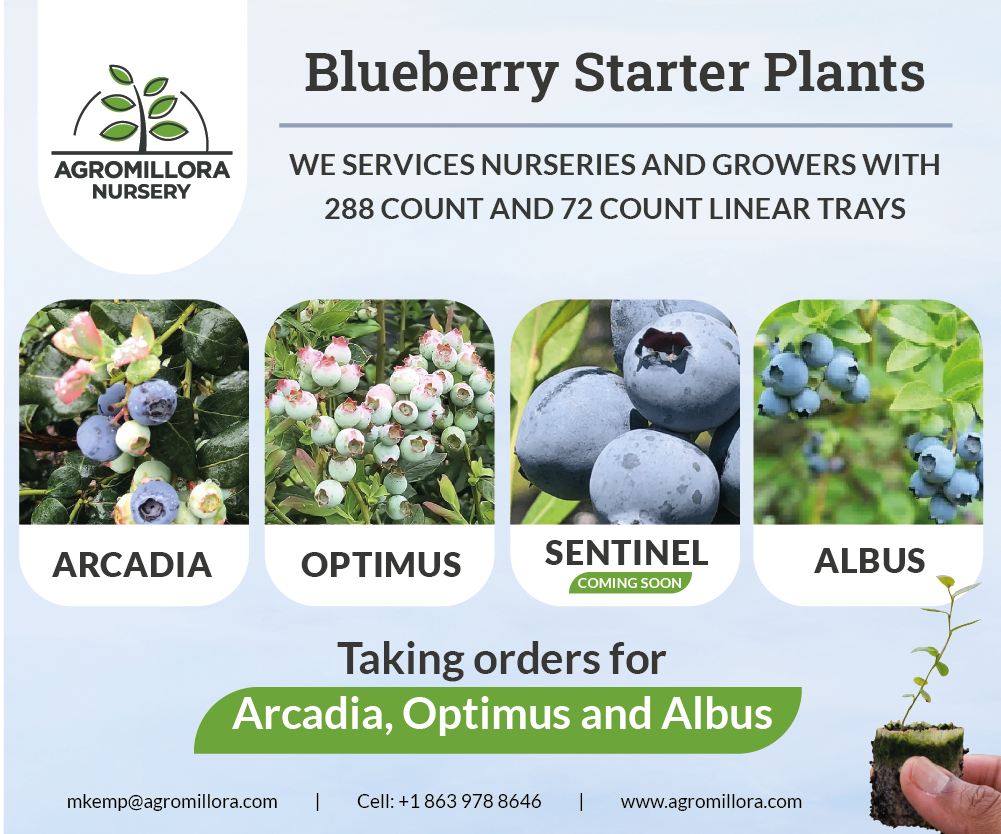Latest Research Shows Blueberry Roots Mining for the Essential Element
Many of us went to school at a time when blueberries were not an important crop in Florida — or anywhere in the world for that matter. Back then, we learned that phosphorus is an essential element for plant growth that is used to make molecules that contain energy (for example, ATP) and information (for example, DNA). We also learned that a steady supply of phosphorus is critical for successful plant production. All these points are still true today. However, many new ideas about phosphorus have been developed recently. What we know about blueberry phosphorus nutrition is quickly expanding thanks to research at UF/IFAS.
Plants take up phosphorus from soil, fertilizers, or both sources. Phosphates are the form of phosphorus that plants take up. Phosphates are very active in the soil due to their charge and reactivity. Phosphates are negatively charged, so they are repelled by soil and pine bark. Long irrigation periods or rain can readily leach phosphates below the plant. On the other hand, phosphates are also very reactive. They bind to other minerals very tightly. This creates a peculiar combination of high leaching potential but low mobility. The best root system to capture phosphates is one that is “steep and deep.” Steep roots are those that have angles that aim lower. Deep roots are those that go far below the plant. Blueberries are known to have very shallow root systems. Unlike fruit trees, they do not have many steep and deep roots. Therefore, blueberry bushes must get creative when foraging for phosphorus. Our research suggests that they use growth or chemical strategies to take up phosphates.
The root growth strategy is simple. The more roots a plant makes, the more phosphorus it can take up. The reason this works is that phosphorus is immobile in the soil. So, more roots can explore more soil and potentially find more phosphorus. We tested whether blueberry plants follow the growth strategy in a hydroponic experiment. We wanted to observe how “Colossus” southern highbush blueberry plants would respond to lack of phosphorus. Would they grow more roots? The answer was a resounding yes (Figure 1). Every variety we have tested in hydroponics grows more roots when it needs more phosphorus. (We have tested a couple of varieties with bird names and a couple of varieties with superhero names.) It only takes a few weeks of phosphorus deficit for plants to start growing new roots. We are very interested in this response because it can be used to stimulate root growth. We will be validating these findings in soils and soilless substrates during the spring of 2024.
There are several chemical strategies a plant can follow. One is to exude sugars to feed the microorganisms in the rhizosphere. These microorganisms, in turn, break down phosphorus-containing minerals with their enzymes (increasing the amount of phosphorus available for plant uptake). Another strategy is for the plant to exude its own enzymes to free up phosphorus. Very little is known about blueberry root capacity to exude sugars, enzymes, or anything else. So we set up a simple experiment to observe whether blueberry plants can use chemical exudates to sustain themselves by solubilizing phosphorus from Florida soils. We planted “Sentinel” and “Optimus” in raised beds made of pine bark incorporated into sandy soil. Test results indicated that phosphorus concentrations in the soil were high. We grew these plants without any phosphorus from fertilizers. We were in for a surprise! “Sentinel” and “Optimus” can grow (so far 15 months) without any phosphorus fertilization. We are eager to learn whether the high phosphorus needs of the cropping season will finally reveal how far root exudates and phosphorus from the soil can take a blueberry plant. One thing is certain, blueberry roots are chemically mining for phosphorus.
There are still many unknowns. For example, we are trying to re-establish the optimum phosphorus concentration in the leaves. We also want to confirm whether there are above-ground symptoms of phosphorus deficiency. Finally, we want to investigate whether high-yielding cultivars require more phosphorus fertilization than lower-yielding ones. Altogether, we are glad to be catching up with what is known about phosphorus nutrition in other crops. In our unique farming system, there are discoveries every step of the way.
Fig 1. Root systems of hydroponically grown blueberry. The plant on the left grew in a complete nutrient solution. The plant on the right grew in a nutrient solution without phosphorus.
Photo credit: Marlon Retana-Cordero
CREDITS:
Gerardo H. Nunez & Marlon Retana-Cordero





